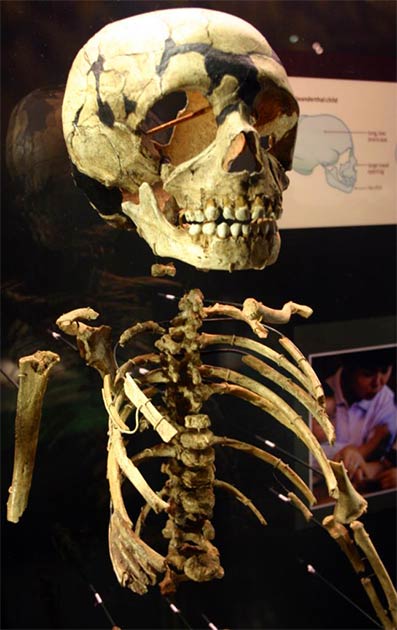A new study proves that just like modern humans, Neanderthal babies were also weaned at six months old.
This fascinating new discovery comes after a team of researchers studied three Neanderthal milk teeth, and it determines that Neanderthal babies were weaned off breast milk at between 5 and 6 months of age. And what this finding effectively achieves is to further expand the quickly swelling database of evidence establishing just how similar modern humans are to our now extinct cousins.
Discovering the Neanderthal Babies’ Wean Cycle
Today, when a mother starts weaning her child has become a personal decision, but changes in breast-feeding patterns begin naturally at age 6 months and this is when solid foods are typically introduced. It is unknown exactly when humans first identified the benefits of weaning, but according to Medcrave, in ancient Egypt breastfeeding was the “first priority of mothers until infants reached six months of age,” when they were weaned and fed cow’s milk .

Neanderthal mother and child (Anthropos Pavilion, Brno, Czech Republic). ( CC BY NC 2.0 )
The new study was published today in the journal Proceedings of the National Academy of Sciences ( PNAS). Professor Alessia Nava, from the University of Kent , who is a co-first author of the study, concluded that Neanderthal children were weaned as babies in a similar time frame to that of modern humans. And the authors say this further cements that the now-extinct species was more similar to Homo sapiens that traditionally believed.
45-70,000-Year-Old Baby Gnashers
The researchers set out to gather new data from three different Neanderthal babies’ teeth excavated in the Riparo Broion Neanderthal site in northeastern Italy, between the current provinces of Vicenza and Verona. Dated to between 70,000 and 45,000 years ago, the teeth were recovered from: the Fumane Cave , Broion Cave , and within the De Nadale Cave .
Combining historical research with time-resolved strontium isotope analyses the researchers used a laser-mass spectrometer to penetrate deep into the past. Like in dendrology, when scientists study the rings on trees, this team of researchers looked at the rings that form naturally in teeth and learned that Neanderthal babies were consuming solids at around six months old.

Presumably a Neanderthal child lost this tooth 40,000 to 70,000 year ago when his or her permanent teeth came in. Credit: ERC project SUCCESS, University of Bologna, Italy
By studying the chemical growth rings of a Neanderthal baby’s tooth scientists can reconstruct accurate models of that being’s lifestyle and dietary habits. Dr. Nava said that the beginning of weaning babies relates “to physiology rather than to cultural factors.” And what the researcher means by this is that around six months old, both modern humans and Neanderthals “need more energetic food supplies.” Co-senior author of the new paper, Professor Stefano Benazzi of the University of Bologna , says these results imply “similar energy demands during early infancy and a close pace of growth between Homo sapiens and Neanderthals.”
Deep Penetrating Implications
Most articles you will read about this new study will have little breathing space, as journalists will struggle for space to explain only the news of the six month similarity between Neanderthal and human weaning patterns. However, if you think about it, the greater implications of study has far reaching significance. So often it is written that Neanderthals are our “closest cousins,” and DNA evidence proves it, but the truth is we don’t know the metabolic rates and constraints of Neanderthals yet. And this means drawing any similarities between how humans and Neanderthals functioned, in life, is greatly educated guess work. Until now that is.

Partial skeleton of a Neanderthal child. (Ryan Somma/ CC BY SA 2.0 )
You see, without this missing metabolic data it is difficult to determine how quickly, or otherwise, Neanderthal’s grew from children to adults. A 2011 New York Times article discussed a paper that concluded “25 percent of adult humans and Neanderthals survived past 40.” This longevity is equal to humans around 50,000 years ago, but scientists in 2011 said they needed to better understand fertility rates and infant mortality rates to determine why human populations expanded and thrived while Neanderthals dwindled to extinction .
Dr. Benazzi says Neanderthal newborns were of “similar weight to modern human neonates” and he says new data indicates that we share a similar “gestational history and early-life ontogeny, and potentially shorter inter-birth interval.” And all this furthers our understanding of how quickly Neanderthal children got from the breast to the hunt, for the want of a better term.
Top Image: Neanderthal babies were also weaned at 6 months old. Source: Anna Goroshnikova / Adobe Stock
By Ashley Cowie
Related posts:
Views: 0
 RSS Feed
RSS Feed

















 November 5th, 2020
November 5th, 2020  Awake Goy
Awake Goy  Posted in
Posted in  Tags:
Tags: 
















